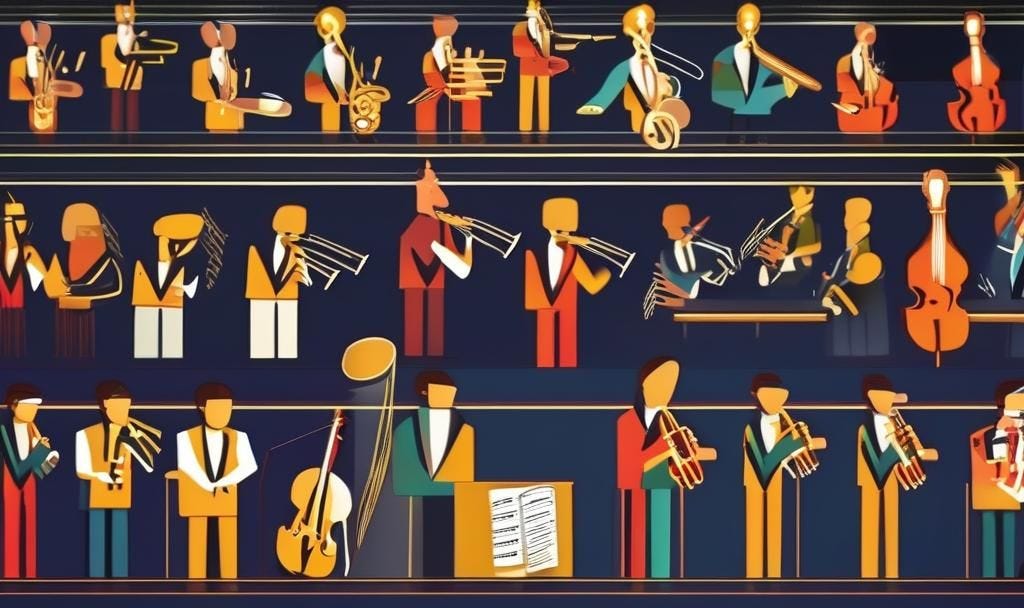In the world of music, jazz bands and classical orchestras offer two distinct approaches to performance, creativity, and leadership. These differences extend beyond music, providing valuable insights into organizational cultures and how to leverage culture for different outcomes.
Jazz Bands: The Power of Flexibility and Shared Leadership
Jazz bands are renowned for their emphasis on improvisation and shared leadership. This approach allows musicians to explore and interpret music in real-time, creating a unique performance every time. Here are some key elements that contribute to the success of jazz bands:
Shared Leadership: In a jazz ensemble, leadership is distributed among all members. Musicians take turns leading through solos, but also engage in subtle leadership by creating space for others to contribute. This fosters a sense of ownership and collaboration, allowing each musician to bring their unique voice to the performance.
Intent Listening: Jazz musicians excel at active listening, which is crucial for successful improvisation. They must be attuned to the contributions of their fellow musicians, responding in real-time to maintain harmony and coherence. This deep communication and tacit understanding enable the band to navigate complex musical landscapes without a central decision-making authority.
Embracing Mistakes: Unlike classical music, where mistakes are frowned upon, jazz embraces them as opportunities for creativity. Errors can lead to unexpected improvisations that enhance the performance. This mindset encourages experimentation and innovation.
Minimal Structure: Jazz musicians operate within a loose framework that balances individual expression with collective coordination. This minimal structure allows for flexibility and spontaneity while maintaining a cohesive sound.
These elements make jazz bands successful in environments that require adaptability and innovation. They thrive on collaboration and the ability to pivot quickly in response to changing dynamics.
Are jazz bands just a bunch of misaligned people though? Arguably, they are more aligned than any other kind of band. Alignment doesn’t occur through sheet music in jazz, but, a strong, shared, and near instinctive understanding of the chord progressions, rhythmic patterns, and form that govern a performance. This sort of alignment takes trust, and months, if not years of performing together, to form.
The ultimate rule of jazz,
If it sounds good, it is good. - Duke Ellington
Classical Orchestras: Precision Through Hierarchical Leadership
Classical orchestras represent a more structured approach, characterized by precision and adherence to a written score. The success of classical orchestras can be attributed to several factors:
Conductor’s Leadership: The conductor plays a pivotal role in guiding the orchestra. They interpret the composer’s vision and communicate it through gestures, ensuring precision, unity, and expressive cohesion. This centralized leadership provides clarity and direction, enabling musicians to perform as a cohesive unit.
Structured Environment: Classical orchestras operate within a highly structured environment where every note is predetermined. This ensures consistency and reliability in performance, which is essential for delivering complex compositions accurately.
Focus on Technical Mastery: Musicians in an orchestra are expected to master their instruments and adhere strictly to the score. This focus on technical excellence ensures that each performance meets high standards of quality.
Cohesion Through Hierarchy: The hierarchical structure of an orchestra facilitates coordination among musicians from different sections. The conductor acts as a mediator, balancing contributions from each section to create a unified sound.
Classical orchestras excel in settings where precision and consistency are paramount. Their structured approach ensures that complex tasks are executed flawlessly.
Organizational Parallels
The differences between jazz bands and classical orchestras mirror those found in organizational cultures:
Agile Teams (Jazz Bands): Agile teams prioritize flexibility, adaptability, and innovation—qualities akin to those of jazz ensembles. For instance, tech companies like Google thrive on this model by encouraging experimentation and rapid iteration.
Hierarchical Organizations (Classical Orchestras): Traditional hierarchical organizations value consistency, reliability, and efficiency. Companies like Walmart, McDonald’s, or the Indian Railways, exemplify this model by maintaining structured processes that ensure operational efficiency.
Different Cultures for Different Outcomes
The comparison between jazz bands and classical orchestras highlights an essential insight: different organizational cultures serve different purposes. An agile, jazz-like culture may be best suited for environments that demand creativity and rapid adaptation. In contrast, a structured, orchestra-like culture is ideal for settings where precision and consistency are crucial.
What’s important for you, the reader, is to know what your organization’s purpose is, and to ensure that your culture mirror’s your purpose.
Cross posted on Substack and LinkedIn. This post represents only my personal views.





Building on your analogy, the movie 'Whiplash' shows how Fletcher, the jazz instructor, uses an iron-fisted approach that clashes with jazz's spirit of shared leadership and improvisation. His extreme control does drive excellence, but at a heavy cost. From both the film and your article, my takeaway is: effective leadership needs to align with the organization’s purpose and values, carefully balancing creativity and structure to achieve the right outcomes.
Nice analogy. Going to be using this one :)